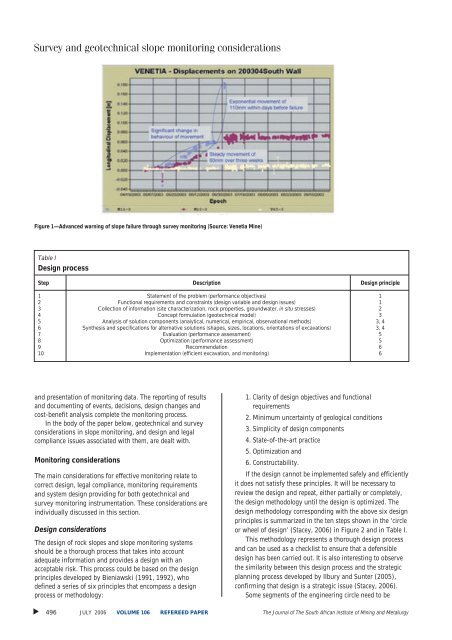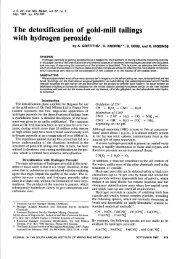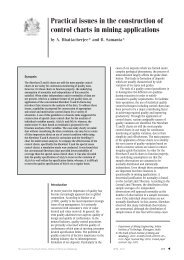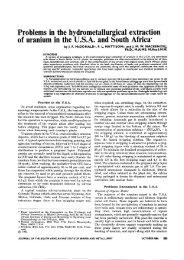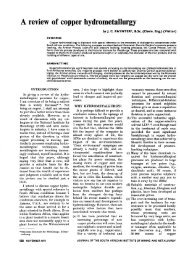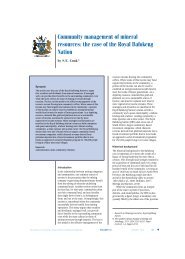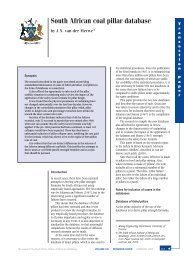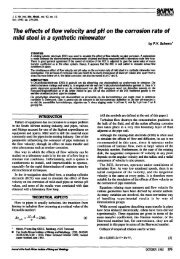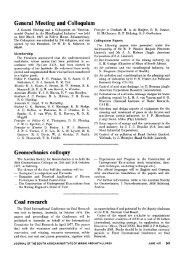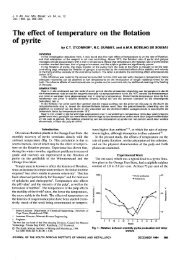Survey and geotechnical slope monitoring considerations - saimm
Survey and geotechnical slope monitoring considerations - saimm
Survey and geotechnical slope monitoring considerations - saimm
You also want an ePaper? Increase the reach of your titles
YUMPU automatically turns print PDFs into web optimized ePapers that Google loves.
<strong>Survey</strong> <strong>and</strong> <strong>geotechnical</strong> <strong>slope</strong> <strong>monitoring</strong> <strong>considerations</strong><br />
Figure 1—Advanced warning of <strong>slope</strong> failure through survey <strong>monitoring</strong> (Source: Venetia Mine)<br />
Table I<br />
Design process<br />
Step Description Design principle<br />
1 Statement of the problem (performance objectives) 1<br />
2 Functional requirements <strong>and</strong> constraints (design variable <strong>and</strong> design issues) 1<br />
3 Collection of information (site characterization, rock properties, groundwater, in situ stresses) 2<br />
4 Concept formulation (<strong>geotechnical</strong> model) 3<br />
5 Analysis of solution components (analytical, numerical, empirical, observational methods) 3, 4<br />
6 Synthesis <strong>and</strong> specifications for alternative solutions (shapes, sizes, locations, orientations of excavations) 3, 4<br />
7 Evaluation (performance assessment) 5<br />
8 Optimization (performance assessment) 5<br />
9 Recommendation 6<br />
10 Implementation (efficient excavation, <strong>and</strong> <strong>monitoring</strong>) 6<br />
<strong>and</strong> presentation of <strong>monitoring</strong> data. The reporting of results<br />
<strong>and</strong> documenting of events, decisions, design changes <strong>and</strong><br />
cost-benefit analysis complete the <strong>monitoring</strong> process.<br />
In the body of the paper below, <strong>geotechnical</strong> <strong>and</strong> survey<br />
<strong>considerations</strong> in <strong>slope</strong> <strong>monitoring</strong>, <strong>and</strong> design <strong>and</strong> legal<br />
compliance issues associated with them, are dealt with.<br />
Monitoring <strong>considerations</strong><br />
The main <strong>considerations</strong> for effective <strong>monitoring</strong> relate to<br />
correct design, legal compliance, <strong>monitoring</strong> requirements<br />
<strong>and</strong> system design providing for both <strong>geotechnical</strong> <strong>and</strong><br />
survey <strong>monitoring</strong> instrumentation. These <strong>considerations</strong> are<br />
individually discussed in this section.<br />
Design <strong>considerations</strong><br />
The design of rock <strong>slope</strong>s <strong>and</strong> <strong>slope</strong> <strong>monitoring</strong> systems<br />
should be a thorough process that takes into account<br />
adequate information <strong>and</strong> provides a design with an<br />
acceptable risk. This process could be based on the design<br />
principles developed by Bieniawski (1991, 1992), who<br />
defined a series of six principles that encompass a design<br />
process or methodology:<br />
1. Clarity of design objectives <strong>and</strong> functional<br />
requirements<br />
2. Minimum uncertainty of geological conditions<br />
3. Simplicity of design components<br />
4. State-of-the-art practice<br />
5. Optimization <strong>and</strong><br />
6. Constructability.<br />
If the design cannot be implemented safely <strong>and</strong> efficiently<br />
it does not satisfy these principles. It will be necessary to<br />
review the design <strong>and</strong> repeat, either partially or completely,<br />
the design methodology until the design is optimized. The<br />
design methodology corresponding with the above six design<br />
principles is summarized in the ten steps shown in the ‘circle<br />
or wheel of design’ (Stacey, 2006) in Figure 2 <strong>and</strong> in Table I.<br />
This methodology represents a thorough design process<br />
<strong>and</strong> can be used as a checklist to ensure that a defensible<br />
design has been carried out. It is also interesting to observe<br />
the similarity between this design process <strong>and</strong> the strategic<br />
planning process developed by Ilbury <strong>and</strong> Sunter (2005),<br />
confirming that design is a strategic issue (Stacey, 2006).<br />
Some segments of the engineering circle need to be<br />
▲<br />
496 JULY 2006 VOLUME 106 REFEREED PAPER The Journal of The South African Institute of Mining <strong>and</strong> Metallurgy


